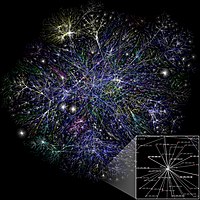
Photo from wikipedia
The extensive use of mobile phones has produced a massive amount of trajectory data and provided the possibility to conduct travel behaviour analyses. In this study, a method of travel… Click to show full abstract
The extensive use of mobile phones has produced a massive amount of trajectory data and provided the possibility to conduct travel behaviour analyses. In this study, a method of travel behaviour analysis is proposed based on extensive trajectory data obtained from Didi Chuxing, China. The travel time regularity and traffic hot spots are analysed from spatial perspectives for three modes: workday, weekend, and the double 11 shopping festival modes. Then a network analysis of the travel hot spots is conducted to study the regularity of travel behaviours. In addition, the travel regularity has been studied and origin/destination prediction of the hot spots has been conducted based on the multivariate -long short-term memory model. The results indicate that the distribution of the travel time during peak hours and at the travel hot spots can effectively reflect the temporal travel regularity of residents. Additionally, the network can reflect the spatial travel regularity of residents. The results provide reference information for improving urban traffic control.
Journal Title: Iet Intelligent Transport Systems
Year Published: 2020
Link to full text (if available)
Share on Social Media: Sign Up to like & get
recommendations!